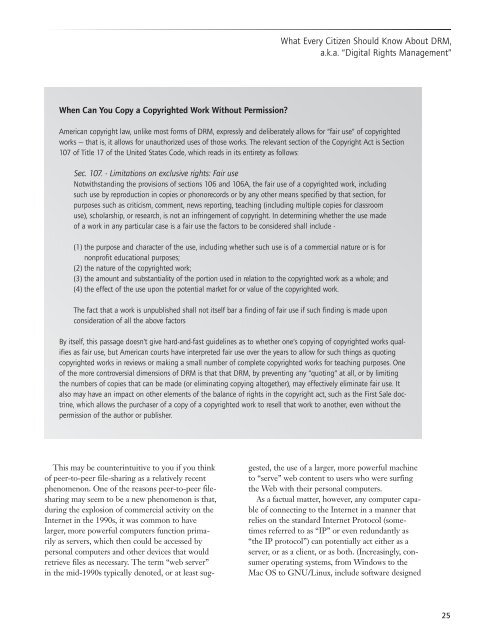What Every Citizen Should Know About DRM, aka - Public Knowledge
What Every Citizen Should Know About DRM, aka - Public Knowledge
What Every Citizen Should Know About DRM, aka - Public Knowledge
Create successful ePaper yourself
Turn your PDF publications into a flip-book with our unique Google optimized e-Paper software.
<strong>What</strong> <strong>Every</strong> <strong>Citizen</strong> <strong>Should</strong> <strong>Know</strong> <strong>About</strong> <strong>DRM</strong>,a.k.a. “Digital Rights Management”When Can You Copy a Copyrighted Work Without Permission?American copyright law, unlike most forms of <strong>DRM</strong>, expressly and deliberately allows for “fair use” of copyrightedworks — that is, it allows for unauthorized uses of those works. The relevant section of the Copyright Act is Section107 of Title 17 of the United States Code, which reads in its entirety as follows:Sec. 107. - Limitations on exclusive rights: Fair useNotwithstanding the provisions of sections 106 and 106A, the fair use of a copyrighted work, includingsuch use by reproduction in copies or phonorecords or by any other means specified by that section, forpurposes such as criticism, comment, news reporting, teaching (including multiple copies for classroomuse), scholarship, or research, is not an infringement of copyright. In determining whether the use madeof a work in any particular case is a fair use the factors to be considered shall include -(1) the purpose and character of the use, including whether such use is of a commercial nature or is fornonprofit educational purposes;(2) the nature of the copyrighted work;(3) the amount and substantiality of the portion used in relation to the copyrighted work as a whole; and(4) the effect of the use upon the potential market for or value of the copyrighted work.The fact that a work is unpublished shall not itself bar a finding of fair use if such finding is made uponconsideration of all the above factorsBy itself, this passage doesn’t give hard-and-fast guidelines as to whether one’s copying of copyrighted works qualifiesas fair use, but American courts have interpreted fair use over the years to allow for such things as quotingcopyrighted works in reviews or making a small number of complete copyrighted works for teaching purposes. Oneof the more controversial dimensions of <strong>DRM</strong> is that that <strong>DRM</strong>, by preventing any “quoting” at all, or by limitingthe numbers of copies that can be made (or eliminating copying altogether), may effectively eliminate fair use. Italso may have an impact on other elements of the balance of rights in the copyright act, such as the First Sale doctrine,which allows the purchaser of a copy of a copyrighted work to resell that work to another, even without thepermission of the author or publisher.This may be counterintuitive to you if you thinkof peer-to-peer file-sharing as a relatively recentphenomenon. One of the reasons peer-to-peer filesharingmay seem to be a new phenomenon is that,during the explosion of commercial activity on theInternet in the 1990s, it was common to havelarger, more powerful computers function primarilyas servers, which then could be accessed bypersonal computers and other devices that wouldretrieve files as necessary. The term “web server”in the mid-1990s typically denoted, or at least sug-gested, the use of a larger, more powerful machineto “serve” web content to users who were surfingthe Web with their personal computers.As a factual matter, however, any computer capableof connecting to the Internet in a manner thatrelies on the standard Internet Protocol (sometimesreferred to as “IP” or even redundantly as“the IP protocol”) can potentially act either as aserver, or as a client, or as both. (Increasingly, consumeroperating systems, from Windows to theMac OS to GNU/Linux, include software designed25





